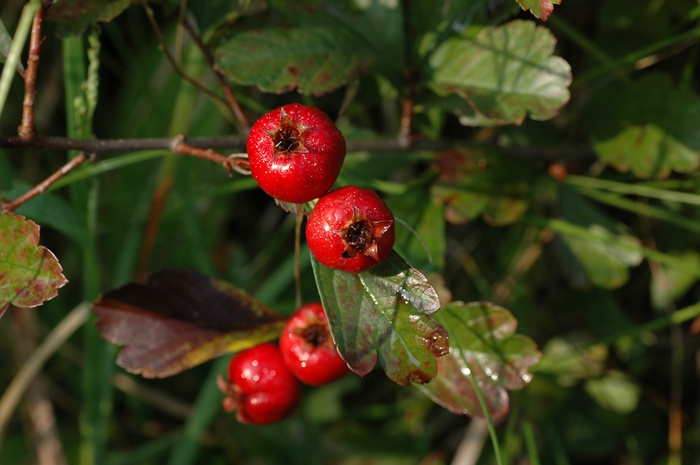- Scientific Name: Crataegus cuneata Siebold & Zucc.
- Ref: Abh. Math.-Phys. Cl. Königl. Bayer. Akad. Wiss. 4(2):130. 1845
- Synonym: Mespilus cuneata (Siebold & Zucc.) K.Koch
- English Common Name: Chinese hawthorn
- Chinese Common Name: 野山楂 yě∙shānzhā, 小叶山楂 xiǎoyè shānzhā
- Japanese Common Name: サンザシ [山査子/山樝子] sanzashi
- Family: Rosaceae
- Genus: Crataegus
- Distribution: Valleys, thickets; 200–2000 m. Anhui, Fujian, Guangdong, Guangxi, Guizhou, Henan, Hubei, Hunan, Jiangsu, Jiangxi, S Shaanxi, Yunnan, Zhejiang [Japan].
- Photo: Qingliang Peak, Zhejiang
Shrubs deciduous, to 15 m tall, usually with slender thorns 5–8 mm. Branchlets purplish brown when young, grayish brown when old, terete, initially pubescent, glabrous when old; buds purplish brown, triangular-ovoid, glabrous, apex obtuse. Stipules falcate, large, 5–8 mm, herbaceous, glabrous, margin serrate, apex acute; petiole 4–5 mm, narrowly winged or not, glabrous; leaf blade broadly obovate to obovate-oblong or obovate-elliptic, 2–6 × 1–4.5 cm, abaxially sparsely pubescent, densely so along veins, glabrescent, with conspicuous veins, adaxially glabrous, base cuneate or attenuate, margin irregularly doubly serrate or serrate, 3-lobed, rarely 5-lobed in apical part or not lobed, apex acute. Corymb 2–2.5 cm in diam., 5–7-flowered, peduncle pubescent; bracts caducous, lanceolate, herbaceous. Pedicel ca. 1 cm, pubescent. Flowers ca. 1 cm in diam. Hypanthium campanulate, abaxially pubescent. Sepals triangular-ovate, ca. 4 mm, both surfaces villous. Petals white, suborbicular or obovate, 6–7 mm. Stamens 20. Ovary pubescent apically, 5-loculed , with 2 ovules per locule; styles 4 or 5, tomentose basally. Pome red or yellow, subglobose or depressed-globose, 1–2 cm in diam., glabrous; sepals often persistent, reflexed; pyrenes 4 or 5, smooth on both inner sides. Fl. May–Jun, fr. Sep–Nov. 2n = 34*. (Flora of China)
